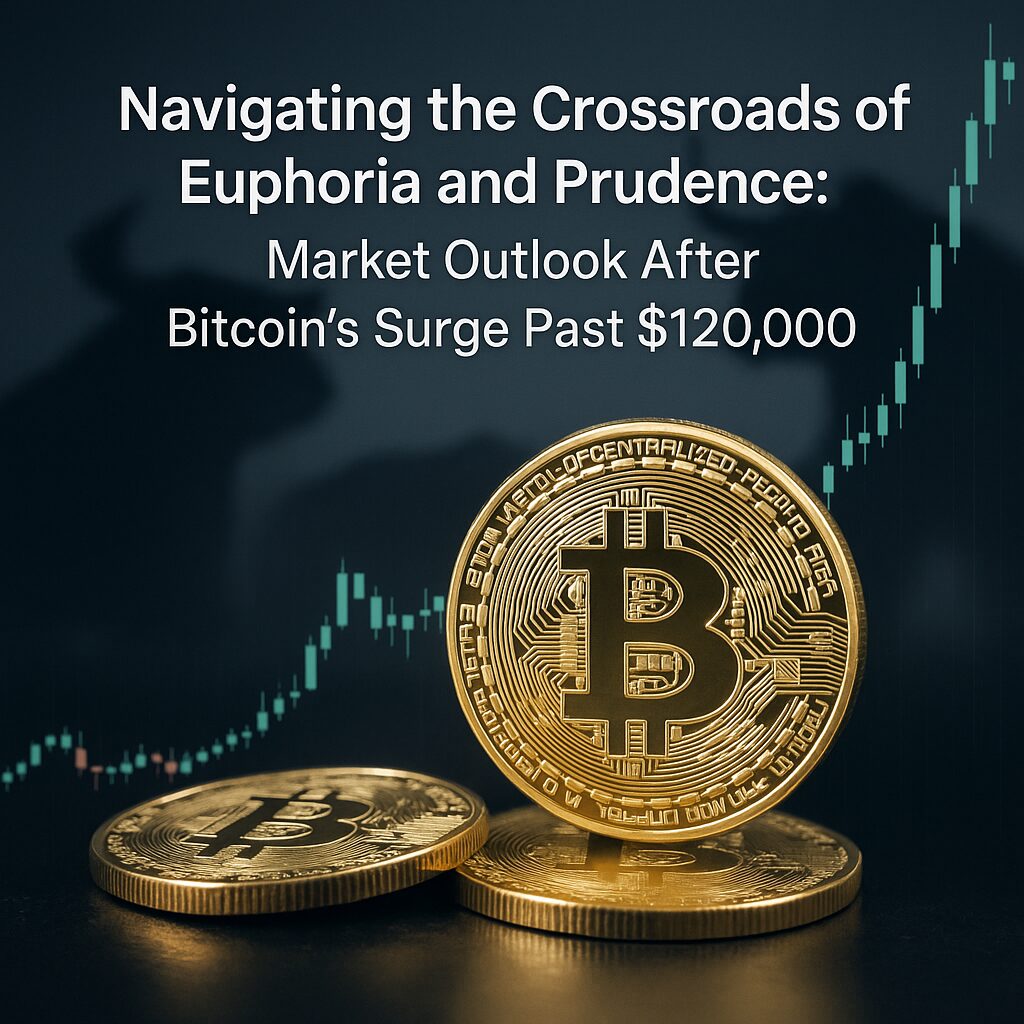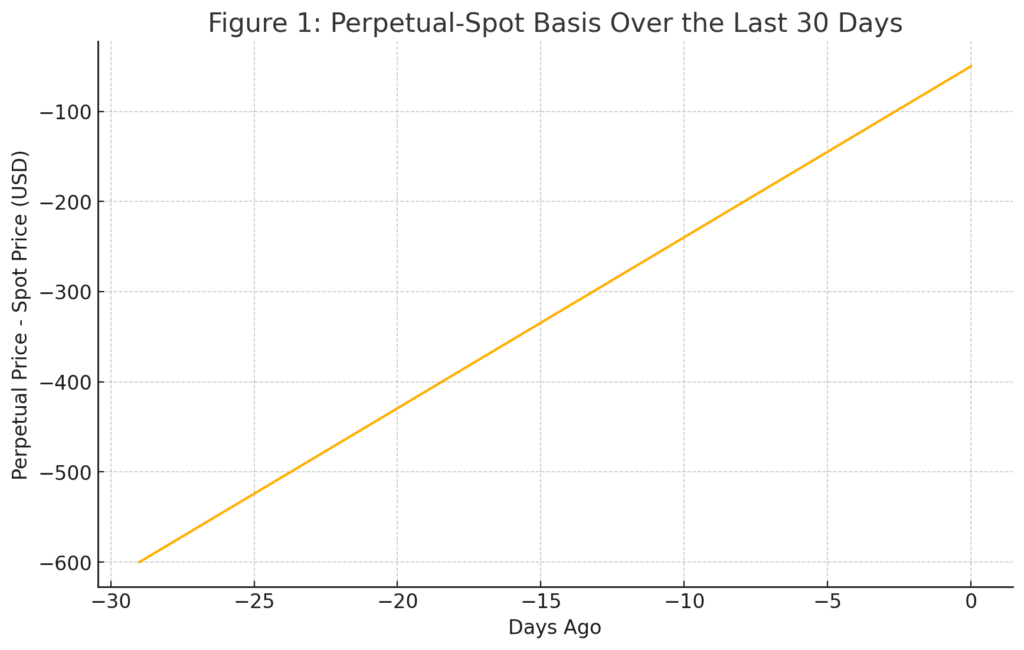
Main Points:
- The perpetual–spot basis remains negative but has narrowed significantly, hinting at a shift from caution to optimism.
- On-chain volume surged by 46.6%, and the cumulative volume delta (CVD) flipped positive, reflecting growing buying conviction.
- Futures open interest reached record highs and funding rates spiked, showing strong bullish positioning in derivatives.
- Institutional demand and ETF inflows underpin a more stable rally, in contrast to prior retail-driven cycles.
- Nearly 99% of Bitcoin’s supply is in profit, elevating the risk of profit-taking and short-term pullbacks.
- U.S. “crypto week” legislative debates and favorable policy sentiment could add fuel to the rally.
1. The Perpetual-Spot Basis: A Barometer of Enthusiasm
The perpetual–spot basis, which measures the difference between high-leverage perpetual swap prices and the actual spot price, has been negative throughout this rally, indicating that traders have been paying a discount for leveraged positions. As of July 14, the basis stood at approximately –$50, compared to nearly –$600 a month ago, signaling that the market has not yet entered full euphoria. Figure 1 illustrates this steady convergence over the last 30 days.

In historical bull phases, when the basis crosses into positive territory, Bitcoin often embarks on parabolic rallies. The narrowing trend suggests that traders are increasingly willing to pay up for perpetual contracts, potentially setting the stage for a decisive shift into a full-blown bull market.
2. On-Chain Metrics: Volume and CVD Signal Conviction
On-chain analytics firm Glassnode reports a dramatic 46.6% jump in spot trading volume on major exchanges following Bitcoin’s breach of $120,000. Concurrently, the cumulative volume delta (CVD)—which tracks net buying versus selling—reversed from negative to positive, underscoring a clear transition from distribution to accumulation.
This shift is significant: rising CVD indicates that buy orders are outstripping sell orders, a hallmark of strong bullish sentiment. Combined with the volume uptick, these metrics reveal that both retail and institutional actors are stepping in with conviction, rather than opportunistic, short-term profit-taking.
3. Derivatives Market Dynamics: Futures and Options at Peak Levels
Derivatives positioning offers further insight. Open interest in Bitcoin futures climbed to a record $57.4 billion, while funding rates—the cost of holding perpetual long positions—surged to levels not seen since late 2023. A spike in funding rates to around $210,000 indicates that longs are paying hefty premiums, a sign of growing risk appetite.
Meanwhile, option-market skews have tilted markedly toward calls, reflecting heightened demand for upside exposure. Yet such crowded positioning elevates the potential for violent corrections if large holders decide to take profits or if market stress triggers deleveraging.
4. Institutional Demand and ETF Flows: New Foundations for a Bull Run
Unlike previous cycles driven primarily by retail speculation, the current rally is underpinned by robust institutional demand. According to Reuters, Bitcoin ETFs attracted $3.4 billion in inflows in July alone—$2.2 billion of which arrived over just two days. Corporate treasuries, sovereign wealth funds, and family offices have also announced fresh allocations to Bitcoin, viewing it as a digital reserve asset.
This structural shift toward longer-term holdings suggests greater price stability and reduced susceptibility to fleeting retail sentiment. Institutional participants typically use less leverage, which may dampen extreme volatility compared to past bull markets.
5. Profitability and Pullback Risks: The Euphoria Conundrum
Glassnode data indicate that nearly 99% of Bitcoin’s circulating supply is currently “in the money,” meaning holders could realize gains at today’s prices. While high profitability can strengthen confidence, it also poses the risk of significant sell-side pressure as investors look to lock in gains.
Historically, similar peaks in on-chain profitability have preceded multi-week corrections. Traders and risk managers should remain vigilant for early signs of distribution—such as cluster selling at key resistance levels—to navigate potential pullbacks.
6. Regulatory Tailwinds: Crypto Week and Legislative Momentum
This rally occurs amid a pivotal week in Washington, D.C. The U.S. House of Representatives is set to debate marquee bills—including the Genius Act (stablecoin framework), the Clarity Act, and the Anti-CBDC Surveillance State Act—collectively dubbed “crypto week.” Market participants interpret these developments as a step toward comprehensive federal regulation, reducing legal uncertainty for institutional players.
President Trump’s vocal support—he has styled himself the “crypto president”—adds political weight to the pro-crypto narrative. Successful passage of these laws could further legitimize digital assets, attract new institutional capital, and sustain the rally into year-end.
Conclusion
Bitcoin’s surge past $120,000 marks a watershed moment, characterized by converging indicators of conviction and risk. The narrowing perpetual basis, robust on-chain volume growth, and record derivatives positioning point to a market inching toward full euphoria. However, the prevalence of profit-in-the-money supply and crowded leveraged positions underscore an elevated correction risk.
Institutional inflows via ETFs and corporate allocations are laying a sturdier foundation for this cycle, potentially ushering in a more mature and sustainable bull market. Meanwhile, U.S. regulatory advances during “crypto week” could provide further structural support.
For investors scouting new crypto opportunities or exploring blockchain’s practical applications, the path ahead will likely feature both powerful momentum and episodic pullbacks. Vigilant risk management and a balanced view of on-chain and off-chain signals will be essential to navigate this crossroads of euphoria and prudence.
